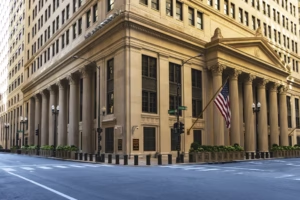Fed Policymakers Reveal Cracks in Consensus
Posted on — Leave a commentThe Federal Reserve held its key interest rate steady today at 4.25-4.50% for the fifth meeting in a row. What wasn’t expected were dissents from two Fed Board Governors, which hasn’t happened in over 30 years.
dissents from two Fed Board Governors, which hasn’t happened in over 30 years.
Fed policymakers typically try to show a united front for its monetary policy decisions. Yet, heightened uncertainty over the impact of protectionist trade policies on our economy is beginning to divide them. Today’s meeting was the first time since 1993 that more than one Board Governor voted against the policy decision. Fed Board Governors Michelle Bowman and Christopher Waller voiced support for an interest rate cut.
Why is the central bank holding back on lowering interest rates? The Fed repeated today that uncertainty about the economic outlook “remains elevated” and that it is appropriate to hold interest rates at current levels since inflation remains above target.
In his press conference after the meeting, Fed Chair Jerome Powell said that keeping rates on hold was “appropriate to guard against inflation risks” as the tariff impact begins to appear in rising consumer prices. Some economists say that it takes time for the impact of protectionist policies to work their way through supply chains and onto store shelves. The Fed has stated it wants to continue to monitor the data in the weeks ahead.
There was little reaction to the Fed news, with stocks trading marginally higher and gold trading slightly lower in afternoon trading.
Gold has settled into a quiet, sideways holding pattern in recent months, after climbing to a record high above $3,400 back in April. Strong central bank buying, uncertainty over the economic impact from shifts to the global trading order, still-high inflation, and wars on several fronts drove safe-haven demand for the metal.
What’s Next for Gold?
Demand for gold remains strong. Central banks continue to diversify away from the U.S. dollar and are increasing their allocation to physical gold. In May, the latest data available, central banks bought 20 tonnes of gold, up from 11 tonnes in April, according to the World Gold Council. And, according to a recent HSBC survey, affluent investors have doubled their allocation to gold from 4%-11%. Finally, Fidelity has released a new forecast, echoing Goldman Sachs, that projects gold will reach $4,000 an ounce.
Gold is expected to break out of its holding pattern and climb to new record levels. The orderly and quiet summer markets create opportune buying periods for long-term investors who want to increase their wealth protection through a bigger allocation to physical gold.
The Fed next meets on September 16-17 and all eyes will remain on the central bank for its next moves. Don’t wait until then to make your next gold move. Consider buying more gold today, while prices are still low.
Photo by Joshua Woroniecki on Unsplash








